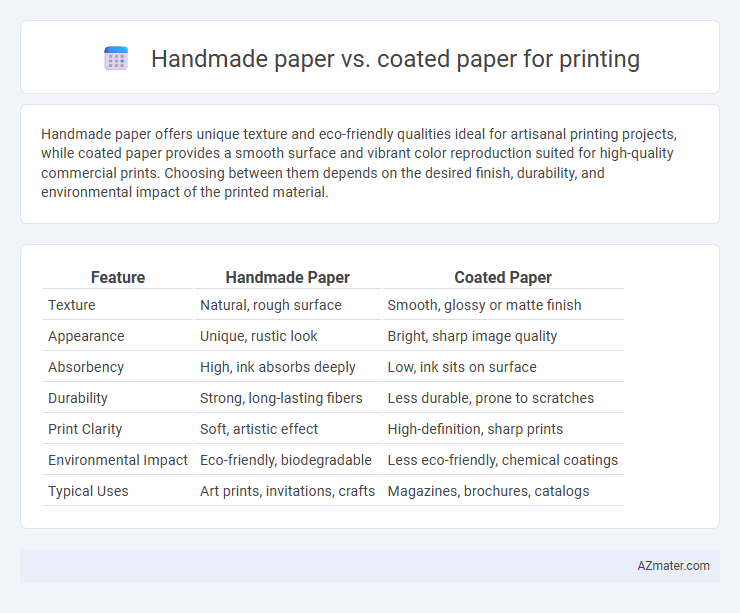Handmade paper offers unique texture and eco-friendly qualities ideal for artisanal printing projects, while coated paper provides a smooth surface and vibrant color reproduction suited for high-quality commercial prints. Choosing between them depends on the desired finish, durability, and environmental impact of the printed material.
Table of Comparison
| Feature | Handmade Paper | Coated Paper |
|---|---|---|
| Texture | Natural, rough surface | Smooth, glossy or matte finish |
| Appearance | Unique, rustic look | Bright, sharp image quality |
| Absorbency | High, ink absorbs deeply | Low, ink sits on surface |
| Durability | Strong, long-lasting fibers | Less durable, prone to scratches |
| Print Clarity | Soft, artistic effect | High-definition, sharp prints |
| Environmental Impact | Eco-friendly, biodegradable | Less eco-friendly, chemical coatings |
| Typical Uses | Art prints, invitations, crafts | Magazines, brochures, catalogs |
Introduction to Handmade Paper and Coated Paper
Handmade paper is crafted using traditional methods involving natural fibers such as cotton, hemp, or mulberry, resulting in a textured, durable sheet with unique aesthetic qualities ideal for artistic and high-end printing projects. Coated paper, on the other hand, is manufactured with a surface layer of clay or polymer that enhances smoothness, brightness, and ink absorption, making it suitable for sharp, vibrant prints in commercial and mass-produced materials. Choosing between handmade and coated paper depends on the desired tactile experience, durability, and visual impact of the final printed product.
Defining Handmade Paper: Origins and Characteristics
Handmade paper originates from traditional papermaking techniques involving manual processing of natural fibers such as cotton, linen, or hemp, resulting in unique textures and irregular edges. This paper is characterized by its high absorbency, durability, and environmental sustainability, making it ideal for artisanal printing projects and fine art prints. Unlike coated paper, handmade paper does not have a glossy or smooth surface, offering a tactile feel that enhances the aesthetic value of printed materials.
What is Coated Paper? Features and Types
Coated paper is a type of paper that has been treated with a surface coating to improve its smoothness, weight, and printability, resulting in sharper and more vibrant images. Its features include a glossy, matte, or satin finish that enhances color reproduction and reduces ink absorption, making it ideal for high-quality printing such as magazines, brochures, and photo books. The main types of coated paper are gloss-coated, which provides a shiny and reflective surface; matte-coated, offering a non-glossy, smooth finish; and silk or satin-coated, which balances between gloss and matte with a soft sheen.
Comparison of Printing Quality: Handmade vs. Coated Paper
Handmade paper offers a unique texture and absorbency that produces rich, organic print results with a tactile feel, ideal for artisan projects and high-end invitations. Coated paper, coated with a glossy or matte finish, provides sharper image reproduction, vibrant colors, and finer detail, making it suitable for commercial printing, photography, and marketing materials. The choice between handmade and coated paper depends on the desired print quality, with coated paper excelling in precision and color saturation, while handmade paper emphasizes texture and natural aesthetics.
Texture and Visual Appeal Differences
Handmade paper offers a unique, tactile texture with natural fibers and irregularities that create a rustic, artisanal feel ideal for premium invitations and art prints. Coated paper features a smooth, glossy or matte surface that enhances color vibrancy and sharpness, making it perfect for high-resolution photographs and professional brochures. The visual appeal of handmade paper lies in its organic, textured finish, while coated paper draws attention with its polished, crisp look.
Environmental Impact and Sustainability Factors
Handmade paper offers superior environmental benefits due to its use of natural fibers, minimal chemical processing, and biodegradability, making it a sustainable choice for eco-conscious printing projects. Coated paper, often produced with chemical additives and plastic-based coatings, poses challenges in recycling and contributes to higher carbon footprints throughout its manufacturing and disposal phases. Choosing handmade paper supports reduced environmental impact by promoting renewable resources and lowering energy consumption compared to the resource-intensive production of coated paper.
Cost Analysis: Handmade Paper vs. Coated Paper
Handmade paper typically incurs higher production costs due to labor-intensive processes and limited scalability, resulting in increased price per sheet compared to mass-produced coated paper. Coated paper benefits from advanced manufacturing techniques and economies of scale, offering lower costs and consistent quality ideal for bulk printing projects. In cost analysis, coated paper is more economical for large volumes, while handmade paper commands a premium for artisanal value and niche applications.
Best Use Cases for Handmade Paper in Printing
Handmade paper excels in luxury stationery, invitations, and art prints where texture and uniqueness enhance the tactile experience, providing a distinct aesthetic compared to coated paper. Its absorbent surface allows for rich, vivid ink absorption, making it ideal for letterpress, calligraphy, and fine art reproductions. Handmade paper is best used in projects emphasizing craftsmanship and exclusivity, such as wedding invitations, certificates, and high-end branding materials.
Ideal Applications for Coated Paper in Printing
Coated paper is ideal for high-quality printing projects such as magazines, brochures, and marketing materials where sharp images and vibrant colors are essential. Its smooth surface enhances ink adhesion and prevents ink bleed, making it suitable for detailed graphics and photographs. Coated paper is preferred in commercial printing environments that demand professional finish and durability.
Choosing the Right Paper: Key Considerations for Printers
Handmade paper offers unique texture and eco-friendly qualities ideal for premium, artistic printing projects, while coated paper provides a smooth surface that enhances color vibrancy and sharpness, making it suitable for high-volume commercial prints. Printers must consider factors like project purpose, desired visual impact, ink absorption, and durability when choosing between the two. Cost efficiency and environmental impact also play crucial roles in selecting the right paper for optimal print quality and customer satisfaction.

Infographic: Handmade paper vs Coated paper for Printing
 azmater.com
azmater.com